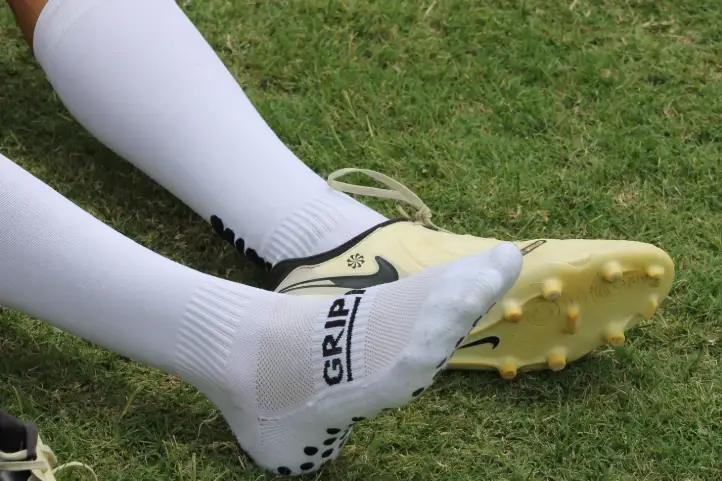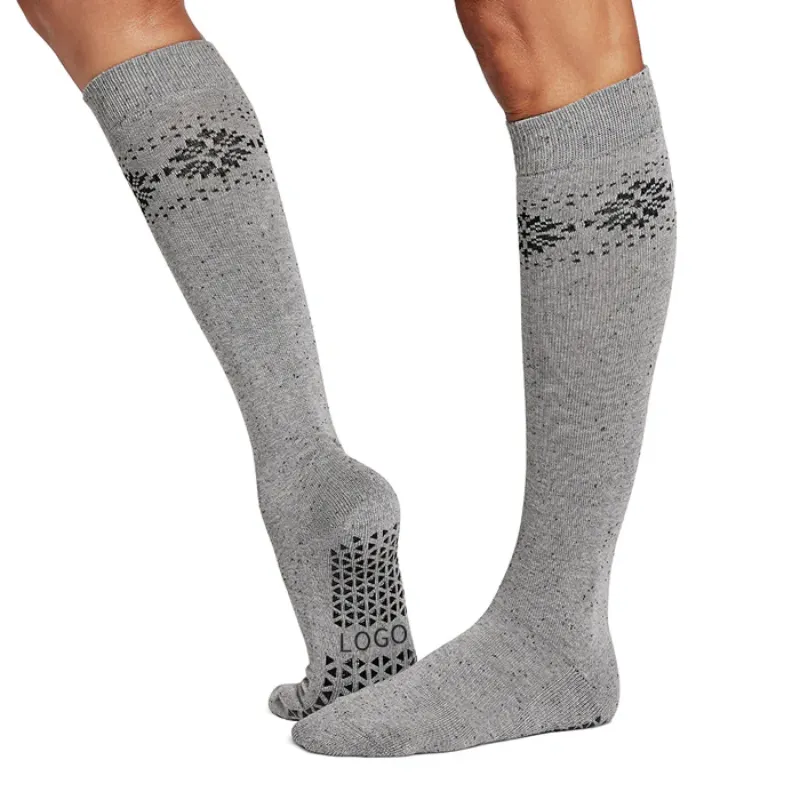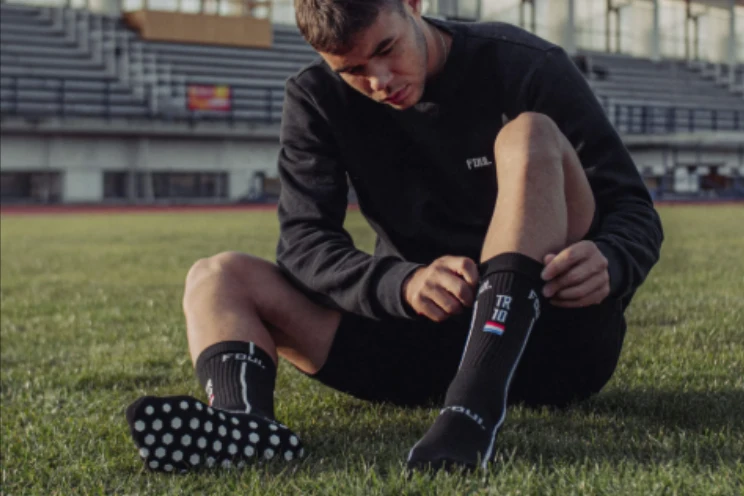Introduction: The Revolution of Grip Technology in Football Footwear
The evolution of football equipment has seen remarkable advancements across all aspects of player gear, with athletic grip socks emerging as a game-changing innovation that addresses the fundamental challenge of stability within footwear. What began as a niche product for elite athletes has transformed into essential equipment for players at all levels seeking to maximize performance and minimize injury risk. Modern athletic grip socks represent the intersection of biomechanical research, material innovation, and practical on-field application. This comprehensive guide explores how these specialized socks have revolutionized the connection between foot and boot, providing enhanced stability, improved performance, and reduced injury risk through strategic grip elements that create a secure foundation for every movement on the pitch.

The Science Behind Grip Technology
Understanding Foot Movement in Football Boots
The biomechanics of foot movement within football boots create unique challenges that traditional socks fail to address. During explosive movements like acceleration, cutting, and jumping, the foot naturally shifts within the boot, creating internal friction and energy loss at this crucial interface. Research using high-speed cameras and pressure mapping has revealed that this micro-movement can reach several millimeters during intense actions, compromising power transfer and stability at critical moments. Athletic grip socks address this fundamental issue by creating strategic friction points between foot, sock, and boot interior, minimizing unwanted movement while allowing necessary flexibility. This scientific approach to the foot-boot interface transforms what was previously an overlooked performance variable into a controllable factor that enhances overall athletic capability.
Friction Coefficient Optimization
The effectiveness of athletic grip socks depends on sophisticated manipulation of friction coefficients at specific contact points. Advanced designs utilize variable grip patterns that create higher friction zones in areas prone to slippage while maintaining lower friction in regions where natural movement is beneficial. This targeted approach prevents the foot from sliding forward during acceleration and deceleration, reduces rotational slippage during cutting movements, and stabilizes the heel during jumping and landing. The most effective grip patterns are developed through extensive testing that identifies precisely where stability is most crucial during sport-specific movements, allowing for grip element placement that maximizes performance benefits without creating uncomfortable restriction or inhibiting necessary foot articulation.
| Aspect | Description | Impact on Performance |
|---|---|---|
| Foot Micro-Movement | Small shifts inside the boot (several mm) during intense actions | Reduces power transfer and stability |
| Friction Points | Strategic zones between foot, sock, and boot creating targeted grip | Minimizes unwanted foot movement |
| Variable Grip Patterns | High friction in slippage-prone areas; low friction where flexibility is needed | Prevents sliding and rotational slippage |
| Pressure Mapping Analysis | Identifies critical areas requiring enhanced grip | Enables precise placement of grip elements |
| Flexibility Preservation | Balances grip strength with necessary foot articulation | Maintains comfort and natural movement |
Performance Enhancement Benefits
Power Transfer Efficiency
One of the most significant performance advantages of athletic grip socks lies in their ability to improve power transfer from the athlete to the playing surface. By minimizing internal foot slippage, these specialized socks ensure that energy generated by the player’s muscles is efficiently transmitted through the foot and boot to the ground rather than being lost to internal movement and friction. This enhanced power transfer is particularly valuable during explosive actions like sprinting and jumping, where maximum force application determines performance outcomes. Players report more responsive acceleration, higher vertical leap, and improved stopping ability when wearing quality grip socks compared to traditional options. These performance gains become especially apparent during fatigue phases when technique naturally deteriorates, providing a competitive advantage in the crucial late stages of competition.
Agility and Cutting Precision
Football demands exceptional agility and directional change capability, with cutting movements representing some of the most technically demanding and physically stressful actions players perform. Athletic grip socks provide crucial stability during these movements by preventing internal foot rotation and forward slippage that commonly occur when changing direction at speed. The enhanced connection between foot and boot allows players to execute cuts with greater confidence and precision, reducing the hesitation that often accompanies concern about stability. This improved cutting capability translates to more effective defensive positioning, sharper attacking movements, and enhanced ability to evade opponents in tight spaces. Many players report that the confidence provided by this stability allows them to attempt more aggressive directional changes that would otherwise feel risky or unstable.
Injury Prevention Capabilities
Blister and Abrasion Reduction
The repetitive friction that occurs between foot and footwear during extended play creates significant blister and abrasion risk that can severely impact performance and training consistency. Athletic grip socks address this common issue through targeted grip elements that minimize the sliding and rubbing that causes skin damage. By stabilizing the foot within the boot, these specialized socks reduce the friction cycles that lead to “hot spots” and eventual blister formation, particularly in vulnerable areas like the heel and ball of the foot. Additionally, many grip sock designs incorporate extra cushioning in high-friction zones, providing further protection against abrasion while maintaining the low-profile fit necessary for optimal touch and feel. This blister prevention capability allows players to maintain consistent training and performance without the interruptions that foot injuries commonly cause.
Ankle and Foot Stability
Beyond skin protection, athletic grip socks contribute significantly to structural stability that can prevent more serious injuries to the ankle and foot. By limiting excessive movement within the boot, these specialized socks reduce the extreme positions that can lead to sprains, strains, and other soft tissue injuries during awkward landings or tackles. The enhanced proprioception provided by grip elements improves the body’s awareness of foot position, allowing for faster corrective responses when balance is challenged. Some advanced designs incorporate additional compression and support elements around the ankle and midfoot, creating a comprehensive stability system that works in conjunction with grip features. This multifaceted approach to foot and ankle stability represents a valuable component in comprehensive injury prevention strategies, particularly for players with histories of lower extremity injuries.
Material Technology Innovations
Advanced Grip Element Compositions
The evolution of grip sock technology has seen remarkable advancements in the materials used for grip elements, moving far beyond the simple rubber dots of early designs. Contemporary options utilize silicone compounds specifically engineered for the unique demands of athletic footwear, providing optimal friction properties while maintaining flexibility and durability through countless movement cycles. Some cutting-edge designs incorporate thermoplastic polymers that respond to body heat, becoming more tacky as foot temperature increases during activity to provide enhanced grip when it’s most needed. Manufacturers continue developing proprietary grip compounds that balance the competing demands of friction, comfort, and longevity, with some premium options maintaining effective grip properties for hundreds of hours of play. These material innovations ensure that modern grip socks deliver consistent performance benefits throughout their usable lifespan.
Base Fabric Engineering for Performance
While grip elements receive the most attention, the base sock fabric plays an equally crucial role in overall performance and comfort. Advanced engineering approaches create specialized knit structures that provide targeted compression, ventilation, and moisture management while serving as the foundation for grip elements. Many premium designs utilize variable density knitting that provides greater support in high-stress areas while enhancing flexibility in regions requiring maximum movement. Moisture-wicking synthetic fibers transport sweat away from the skin to prevent the slickness that compromises grip effectiveness, while antimicrobial treatments prevent odor development during extended use. This sophisticated approach to base fabric construction ensures that athletic grip socks deliver comprehensive performance benefits beyond the obvious grip advantages, creating a complete system that enhances every aspect of foot function during play.
Selection Considerations for Players
Sport-Specific Grip Patterns

Different sports and playing positions create unique demands that influence optimal grip sock selection. Football players who perform frequent cutting movements benefit from designs with extensive lateral grip coverage that prevents internal foot rotation. Goalkeepers often prefer options with enhanced heel and forefoot grip that provide stability during explosive lateral movements and jumps. Speed-focused positions might prioritize lightweight designs with strategic grip placement that provides stability without adding bulk. Understanding these sport-specific requirements helps players select grip socks that complement their particular role demands rather than generic options that might not address their unique stability challenges. This targeted approach to selection ensures maximum performance benefit from the specialized technology these socks provide.
Fit Factors Beyond Basic Sizing
Achieving maximum benefits from athletic grip socks requires proper sizing based on comprehensive measurements rather than general size categories. Foot length, arch height, and ankle circumference all influence how grip elements align with the foot’s natural structure and movement patterns. Too-large socks create excess material that can bunch and fold, potentially causing the discomfort and blisters the product aims to prevent. Conversely, undersized options may place grip elements in incorrect positions while creating uncomfortable restriction. Many players mistakenly select grip socks based on their regular sock or shoe size rather than consulting specific sizing guides provided by manufacturers. The ideal fit should create a second-skin sensation with grip elements precisely positioned at key stability points without causing discomfort or restriction.
Integration with Football Boots
Compatibility Considerations with Different Boot Types
The effectiveness of athletic grip socks varies significantly based on the football boot design they’re paired with, creating important compatibility considerations for optimal performance. Low-volume speed boots with minimal internal space benefit from thinner grip sock designs that provide stability without creating uncomfortable pressure points. Boots with wider toe boxes may require grip socks with more extensive forefoot grip coverage to prevent excess movement in this larger space. The internal texture of the boot also influences grip sock selection, with smooth synthetic liners typically requiring more aggressive grip patterns than boots with naturally tacky internal surfaces. Understanding these compatibility factors helps players create integrated foot-sock-boot systems that maximize stability and comfort rather than treating each element as an isolated component.
Creating Complete Stability Systems
Advanced players and teams approach foot stability as a comprehensive system rather than relying solely on grip socks for this crucial performance factor. Insole selection, lacing techniques, and boot choice all work in conjunction with grip socks to create complete stability solutions tailored to individual needs. Some players implement personalized systems where different grip sock styles are paired with specific boots for various playing conditions or match situations. Professional teams often develop systematic approaches where grip sock selection is coordinated with footwear choices and even playing surface characteristics to optimize stability across all variables. This systems-based approach recognizes that grip socks represent one component, albeit an important one, in the complex equation of foot stability and performance optimization.
Maintenance Best Practices
Washing Techniques for Grip Preservation
Proper washing is essential to keep athletic grip socks performing at their best. Always turn socks inside-out before washing. This protects the grip patterns from rubbing against other fabrics, which can cause abrasion and wear. Use cold water to avoid heat damage that can weaken silicone or rubber grip elements. Fabric softeners should be avoided entirely because their residues reduce both moisture-wicking abilities and grip effectiveness. After washing, air drying is highly recommended. High heat from dryers can permanently damage grip materials and elastic fibers, shortening the sock’s lifespan. Following these care steps helps ensure your grip socks maintain their performance and comfort through many washes.
Recognizing Replacement Indicators
No matter how well you care for them, grip socks will eventually lose effectiveness. It’s important to watch for signs that indicate it’s time to replace them. Key indicators include grip patterns that appear flattened or smooth, a loss of tackiness when touched, or grips peeling away from the fabric. Most quality grip socks last about 25 to 40 wear-and-wash cycles before performance declines. This varies depending on how often you use them and the intensity of activity. Regularly comparing older socks to newer pairs can help you detect changes early. Replacing socks proactively keeps performance consistent and reduces the risk of slipping or discomfort during play.
| Care Aspect | Best Practice | Reason |
|---|---|---|
| Washing Method | Turn socks inside-out, wash in cold water | Protects grip patterns, avoids heat damage |
| Detergent Use | Avoid fabric softeners | Prevents residue buildup, maintains grip |
| Drying Method | Air dry, avoid high heat | Preserves elastic and grip materials |
| Replacement Signs | Flattened grip, loss of tackiness, peeling grips | Indicates reduced performance |
| Typical Lifespan | 25-40 wear-and-wash cycles | Depends on use intensity and care |
Professional Implementation Strategies
How Elite Teams Utilize Grip Technology
Professional football clubs have developed sophisticated approaches to grip sock implementation that maximize their performance benefits across diverse player needs. Many elite teams conduct individual foot assessments that identify specific stability challenges for each athlete, allowing for personalized sock recommendations that address unique biomechanical patterns. Some organizations implement systematic rotation programs that track usage and washing cycles, ensuring timely replacement before performance degradation occurs. Advanced teams even coordinate grip sock selection with specific match conditions, providing players with multiple options optimized for different playing surfaces and weather scenarios. These comprehensive approaches demonstrate how seriously professional organizations take this seemingly minor equipment element due to its significant impact on performance and injury prevention.
Customization Options for Team Applications
Beyond standard retail options, many teams pursue customized grip sock solutions that address their specific performance requirements while incorporating team identity elements. Custom grip pattern designs can target the particular stability challenges encountered in specific playing styles or position responsibilities. Team color integration and logo placement create visual cohesion with other uniform elements while maintaining full performance functionality. Some organizations work directly with manufacturers to develop proprietary grip technologies exclusive to their programs, creating competitive advantages through equipment innovation. These customization approaches allow teams to optimize both the performance and identity aspects of grip socks rather than accepting standardized solutions designed for general market applications.
Conclusion: The Competitive Edge of Proper Foot Stability
Athletic grip socks have evolved from niche accessories into essential performance gear. They provide proven benefits that directly address foot stability challenges within football boots. These socks improve power transfer, agility, reduce blister risks, and enhance proprioception—key factors for players aiming to gain an edge on the field. Understanding their benefits, how to choose the right pair, and proper care helps players make smart decisions when adding grip socks to their football kit.

With ongoing advances in material science and sports research, athletic grip socks will continue to improve, offering even greater support and functionality. Players who adopt these innovations stay ahead in performance, making the most of every advantage. Whether you are a professional chasing every marginal gain or a recreational player focused on comfort and injury prevention, high-quality grip socks deliver value well beyond their cost.
If you want to explore tailored options that meet your specific needs, we invite you to visit our website and discover how Max Hosiery can help you customize football socks designed for your best performance. Start your partnership with us today and experience the difference that smart sock design can make for your game.
FAQ Section
Do athletic grip socks actually improve performance or are they mostly psychological?
Research confirms measurable performance improvements, with studies showing reduced in-boot foot movement of up to 45%, enhanced power transfer during explosive movements, and significantly reduced blister formation, though the confidence boost provides additional psychological benefits.
How long do grip elements typically last before losing effectiveness?
Quality grip elements maintain optimal tackiness for approximately 25-40 wearing cycles with proper care, though this varies based on play intensity, washing frequency, and care practices like avoiding fabric softeners and high-heat drying.
Can grip socks be worn with any type of football boot?
While compatible with most boots, optimal performance requires matching grip sock thickness and pattern to specific boot types—thinner patterns work best with tight-fitting speed boots, while more extensive grip coverage benefits boots with roomier toe boxes.
Are there different grip socks for different playing positions?
Yes, position-specific designs exist with defenders and midfielders benefiting from extensive lateral grip coverage, forwards typically preferring forefoot emphasis for acceleration, and goalkeepers utilizing specialized patterns with enhanced heel stability for explosive lateral movements.
How do I know when it’s time to replace my grip socks?
Replace grip socks when you notice visible flattening of grip elements, decreased tackiness when touched, separation of grip material from the base fabric, or when you experience increased foot movement within boots compared to when the socks were new.
